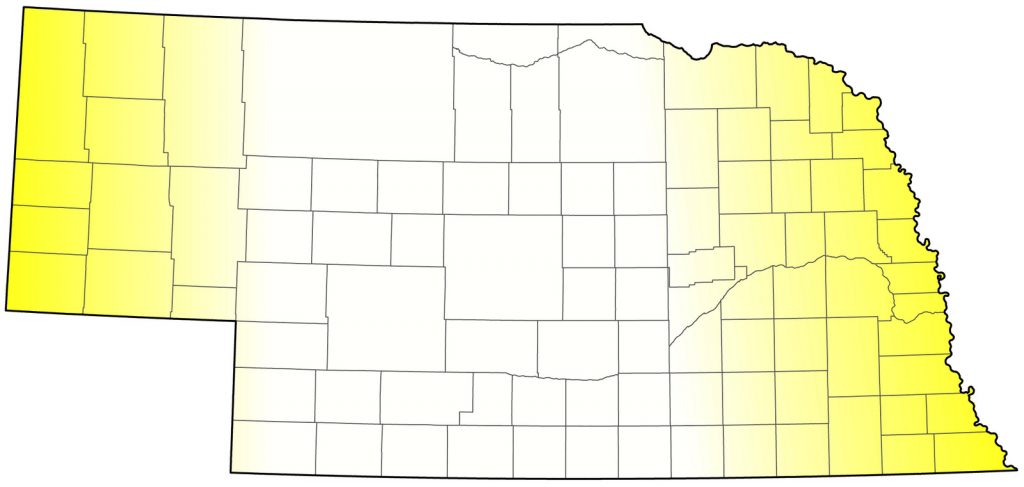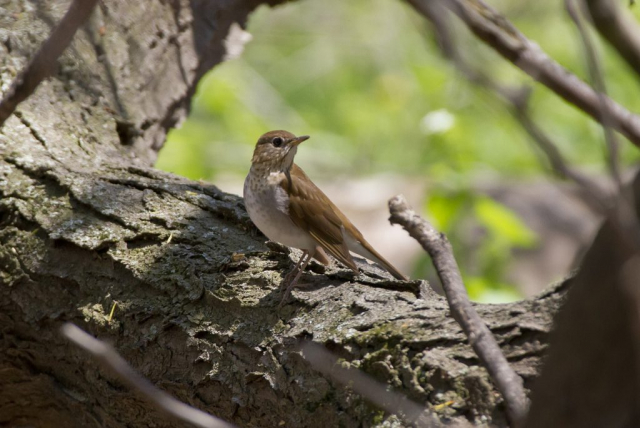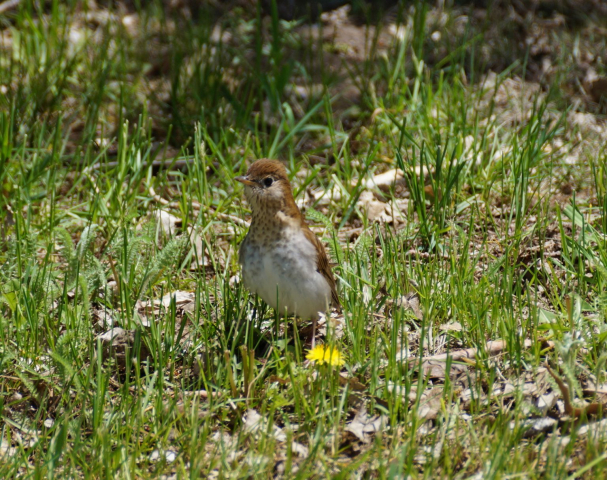Catharus fuscescens levyi/salicicolus, C. F. Fuscescens?
Status: Uncommon regular spring migrant east and west, rare central. Rare regular fall migrant east and west.

Documentation: Specimen: UNSM ZM11022 (salicicolus/levyi?), 25 May 1909 Lincoln, Lancaster Co.
Taxonomy: Four subspecies are recognized (AviList 2025), subpallidus, breeding from northern Washington east of the Cascades south to northeastern Oregon and east to northern and central Idaho and western Montana, salicicolus, breeding from British Columbia to Alberta, northern Michigan and Wisconsin, south through the Rocky Mountains to Colorado and northeastern Arizona, fuliginosus, breeding in Newfoundland, and fuscescens, breeding south of fuliginosus in eastern North America from Ontario east to New Brunswick and Nova Scotia.
Field identification and even museum identification of Veery subspecies, and indeed the species, is tricky, largely due to foxing of older specimens (Phillips 1991). Prior to Phillips (1991), two Veery subspecies had been recorded in Nebraska (Rapp et al 1958), eastern fuscescens and western salicicolus. Phillips (1991) separated former salicicolus Veeries breeding from Alberta to Wisconsin as levyi; this subspecies is not as reddish as fuscescens, but more so than salicicolus. Since Phillips (1991) considered migrant levyi to occur in a corridor between eastern New Mexico and Mississippi, most migrant Veeries in at least eastern Nebraska are likely levyi. Nebraska Veeries are clinal in extent of brownish/reddish coloration, brownish/reddish in the east due to presence of migrant levyi, and grayer in the west due to migrant salicicolus.
The occurrence of fuscescens in Nebraska is not well-documented; as indicated by Phillips (1991), identification of specimens is difficult. Rapp et al (1958) stated that fuscescens was a “rare migrant in the Missouri River Valley,” while salicicolus “is more common in the western half of the state than in the east.” Based on currently understood breeding ranges, however (Phillips 1991, Herkscher et al 2020), fuscescens breeds from Ontario eastward and in the Appalachian Mountains and would seem unlikely to occur in Nebraska. Nevertheless, Phillips (1991) stated that fuscescens was a migrant west “casually” to western Oklahoma and east-central Colorado and indeed “not common” even in Arkansas. The westernmost documented Nebraska record of fuscescens is a specimen, #2043 in the Brooking Collection, taken at Inland, Clay Co 3 May 1915 and identical to specimens at UNSM identified as this subspecies by Oberholser (Swenk, Notes Before 1925); it is uncertain whether this specimen would be assigned to levyi or not under current taxonomy. A photograph herein by JGG taken at Harrison, Sioux Co 25 May 2001 shows a quite rusty plumage, and a very rusty bird at Lake Ogallala, Keith Co 5 Sep 2013 may have been fuscescens; a probable fuscescens was at Rock Creek SRA, Dundy Co 31 Aug 2017. Perhaps these reports of rusty Nebraska Veeries are indeed of levyi.
Subspecies salicicolus breeds in the Rocky Mountains and has a disjunct population in the South Dakota Black Hills (Drilling et al 2018). It is the expected migrant in western Nebraska, although at least some subpallidus might occur as well.
Spring: May 1, 1, 1 <<<>>> May 31, 31, Jun 1
Later dates are 3 Jun 2023 Dakota Co, 9-10 Jun 2024 Fort Robinson SP, Dawes Co, 12 Jun 2001 Washington Co, and 18 Jun 1981 Garden Co.
Almost all Veeries migrate across the Gulf of Mexico in spring and fall, and those breeding in the western and northwestern USA, subpallidus, salicicolus and levyi, migrate north and then west in spring and the reverse in fall (Heckscher et al 2020). Maps in eBird (eBird.org, accessed Nov 2023) show all Veeries still in the eastern half of the USA in April, but by late May western breeders have occupied the Rocky Mountains (salicicolus) and points further north and west (subpallidus). Because Veeries occur statewide in spring in Kansas (Thompson et al 2011) but primarily only in eastern and western Nebraska (not central), separation of migrating western breeders subpallidus and salicicolus from central Canadian levyi probably is centered on Kansas; Veeries are expected only in spring in eastern Oklahoma (Oklahoma Bird Records Committee 2014).
The few western reports, all likely salicicolus, are essentially limited to the Panhandle. Most are since 2000 as observers have been more aware of Veery subspecies. Fred Zeillemaker netted 1-2 each spring in Garden Co 1978-1981 (Roger Sharpe, personal communication), and Benckeser (1951) thought it “unusually common” in Keith Co in spring 1950. The only other westerly reports are of three in Sheridan Co 15 May 2002, 18 May 2022 Scotts Bluff Co, 21 May 1988 Scotts Bluff Co, 21 May 2020 in Cheyenne Co, 21 May 2020 at Oliver Reservoir, Kimball Co, 21 May 2020 Gering Cemetery, Scotts Bluff Co, 22-26 May 2022 (at least 2) Oliver Reservoir, 23 May 2020 Dawes Co, 23 May 2020 Box Butte Reservoir, Dawes Co, 27 May 2013 Lincoln Co, 31 May 2008 Lincoln Co, 1 Jun 2013 Dawes Co, 7 Jun 2025 Lincoln Co, 9-10 Jun 2024 Fort Robinson SP, Dawes Co, and 18 Jun 1981 Garden Co. In 2023, however, there were seven reported from six west and west central locations 14-22 May, and in 2024, eight were reported from four Panhandle locations 16-28 May, including five at Oliver Reservoir 20-28 May.
Regular reports in the east, presumably of levyi, extend west to Hall Co and the Rainwater Basin; Jorgensen (2012) noted 13 overall reports in the eastern Rainwater Basin 3-22 May, and there are reports 8 Jul 1988 Howard/Hall Cos and 22 May 2020 Harlan Co.
Furthest west reports of presumed eastern migrants are 9 May 2023 Rock Co, 14 May 2015 Buffalo Co, and 17 May 2010 Buffalo Co.
- High counts: A total of 7 were reported in Sarpy Co 11-31 May 1992, considered a good migration (Grzybowski 1993), 14 were reported 5-27 May 2013 statewide, 21 from 15-25 May in 2020, and 15 from 3-28 May in 2024. Three were in Sheridan Co 15 May 2002.
Fall: Aug 18, 20, 21 (Williams 1987) <<<>>> Sep 22, 25, 25
There are far fewer reports in fall than in spring; Heckscher et al (2020) state that Veeries breeding in the northwestern parts of the range migrate east before heading south and crossing the Gulf of Mexico along with eastern Veeries. Veeries in fall in Oklahoma have been identified as salicicolus (Joseph Grzybowski, personal communication), presumably as a result of this eastward shift in fall.
Veeries (salicicolus) breed in the Black Hills of South Dakota and leave there by Sep (Peterson 1990, Tallman et al 2002), which suggests that the few westerly Nebraska reports are indeed of salicicolus: 18 Aug 1981 Garden Co, 22 Aug 1987 McPherson Co, 23 Aug 1981 Garden Co, singles netted 28 Aug and 2 Sep 1979 in Garden Co (Williams 1980), one netted in southern Sioux Co 30 Aug 2001 and identified as salicicolus, one at Chadron SP, Dawes Co 3 Sep 2018, and one netted and photographed at Chadron SP 12 Sep 2013 (Novak 2013).
Fred Zeillemaker netted 1-2 Veeries each fall in Garden Co 1978-1981 (Roger Sharpe, personal communication).
Comments: There are eight reports in the east that raise the possibility of breeding, although four of these are for 12-18 Jun and may be late migrants. All are before 2010; we believe that most of these reports are misidentifications, likely of Wood Thrush. There is no direct evidence for nesting by Veery in Nebraska, although it is a rare breeder as near as central Iowa (two records, Kent and Dinsmore 1996). The Nebraska summer reports are 11 Jun 1978 Douglas-Sarpy Cos, 12 Jun 1983 Douglas-Sarpy Cos (Williams 1983), 12 Jun 2001 Washington Co, 14 Jun 1972 Brown Co, 18 Jun 1992 Sarpy Co (Grzybowski 1992), 2-11 Jul 1977 Douglas-Sarpy Cos, and 9 Jul-23 Aug 1981 Douglas-Sarpy Cos, 29 Jul 1981 Sarpy Co, and 6 Aug 2009 Otoe Co.
There are no summer reports from western Nebraska in suitable breeding habitat, although Veeries breed uncommonly in the Black Hills (Tallman et al 2002, Drilling et al 2018) and in southeast Wyoming (Faulkner 2010).
Images
Abbreviations
SP: State Park
SRA: State Recreation Area
UNSM: University of Nebraska State Museum
Literature Cited
AviList Core Team, 2025. AviList: The Global Avian Checklist, v2025. https://doi.org/10.2173/avilist.v2025.
Benckeser, H.R. 1951. Notes from Keth County. NBR 19: 9-10.
Drilling, N.E., E.D Stukel, R.A. Sparks, and B.J. Woiderski. 2018. The Second Atlas of Breeding Birds of South Dakota. SDGFP, Wildlife Division Report 2017-02. South Dakota Game, Fish, and Parks, Pierre.
Faulkner, D.W. 2010. Birds of Wyoming. Roberts and Company, Greenwood Village, Colorado, USA.
Gill, F., D. Donsker, and P. Rasmussen (Eds). 2022. IOC World Bird List (v 12.2). Doi 10.14344/IOC.ML.12.2. http://www.worldbirdnames.org/.
Grzybowski, J.A. 1992. Southern Great Plains Region. American Birds 46: 443-446.
Grzybowski, J.A. 1993. Southern Great Plains Region. American Birds 47: 426-429.
Heckscher, C.M., L.R. Bevier, A.F. Poole, W. Moskoff, P. Pyle, and M.A. Patten. 2020. Veery (Catharus fuscescens), version 1.0. In Birds of the World (P. G. Rodewald, Editor). Cornell Lab of Ornithology, Ithaca, NY, USA. https://doi.org/10.2173/bow.veery.01.
Jorgensen, J.G. 2012. Birds of the Rainwater Basin, Nebraska. Nebraska Game and Parks Commission, Lincoln, Nebraska, USA.
Kent, T.H., and J.J. Dinsmore. 1996. Birds in Iowa. Publshed by the authors, Iowa City and Ames, Iowa, USA.
Novak, M. 2013. Checklist S15249416: Chadron SP, Dawes County, Nebraska, US. eBird.org, accessed 18 Jun 2018.
Oklahoma Bird Records Committee. 2014. Date Guide to the occurrences of birds in Oklahoma. Sixth edition. Oklahoma Ornithological Society, Edmond, Oklahoma, USA.
Peterson, R.A. 1990. A birdwatcher’s guide to the Black Hills. PC Publishing, Vermillion, South Dakota, USA.
Phillips, A.R. 1991. The known birds of North and Middle America. Part 2. Published by the author, Denver Colorado, USA.
Rapp, W.F. Jr., J.L.C. Rapp, H.E. Baumgarten, and R.A. Moser. 1958. Revised checklist of Nebraska birds. Occasional Papers 5, Nebraska Ornithologists’ Union, Crete, Nebraska, USA.
Swenk, M.H. Notes before 1925. Bird notes from A.M. Brooking of Hastings, C.A. Black of Kearney, and B.J. Olson of Kearney, based chiefly on their collections, up to January 1, 1925. Typed manuscript in the Nebraska Ornithologists’ Union Archives, University of Nebraska State Museum, Lincoln, Nebraska, USA.
Tallman, D.A., Swanson, D.L., and J.S. Palmer. 2002. Birds of South Dakota. Midstates/Quality Quick Print, Aberdeen, South Dakota, USA.
Thompson, M.C., C.A. Ely, B. Gress, C. Otte, S.T. Patti, D. Seibel, and E.A. Young. 2011. Birds of Kansas. University Press of Kansas, Lawrence, Kansas, USA.
Williams, F. 1980. Southern Great Plains Region. American Birds 34: 176-179.
Williams, F. 1983. Southern Great Plains Region. American Birds 37: 967-1030.
Williams, F. 1987. Southern Great Plains Region. American Birds 41: 109-113.
Recommended Citation
Silcock, W.R., and J.G. Jorgensen. 2025. Veery (Catharus fuscescens). In Birds of Nebraska — Online. www.BirdsofNebraska.org
Birds of Nebraska – Online
Updated 28 Aug 2025


